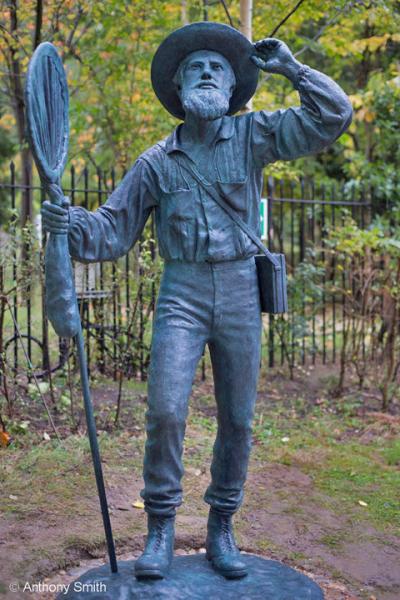Alfred Russel Wallace in the Malay Archipelago – The Singapore Statue Campaign
By Barry Clarke
 Inspired by seeing the splendid statue of Alfred Russel Wallace by Anthony Smith at the Natural History Museum, London (right), I have initiated a campaign to have a replica statue of the great man erected in Singapore. After all, it was in Singapore where Wallace started his exploration of the Malay Archipelago. He arrived in 1854 and within two months he collected 700 species of beetles. He later wrote of his first visit to Singapore:
Inspired by seeing the splendid statue of Alfred Russel Wallace by Anthony Smith at the Natural History Museum, London (right), I have initiated a campaign to have a replica statue of the great man erected in Singapore. After all, it was in Singapore where Wallace started his exploration of the Malay Archipelago. He arrived in 1854 and within two months he collected 700 species of beetles. He later wrote of his first visit to Singapore:
“… I was quite satisfied with these my first attempts to gain a knowledge of the Natural History of the Malay Archipelago.”
Since Singapore had a role in the formation of Wallace’s ideas about evolution, I and many others feel that there should be a permanent memorial to the great man – what better way to remember him than with a statue? Peter Ng, Director of the new Lee Kong Chian Natural History Museum strongly agrees and is looking forward to having the statue as an additional attraction at what will be the best museum of natural history in a critically important region for biodiversity. This new museum inherited its natural history collection from the famous Raffles Museum of Biodiversity Research, named after the man recognized as the founder of modern-day Singapore. The collection remains under the auspices of the National University of Singapore where the new museum is located.
Stamford Raffles was an amateur naturalist and apart from lending his name to Rafflesia, the plant with the world's largest flower, he was responsible for the collecting and naming of many species in SE Asia. He even mooted the idea of a museum of specimens from the region, but he only pursued the idea on returning to England where he helped established the Royal Zoological Society of London. One of Raffles’ many legacies is that he applied Western science to the discovery, naming and documenting of the biodiversity of SE Asia.
It is a remarkable coincidence that both Raffles and Wallace lost vast collections in ships that burnt and sunk on homeward journeys. Raffles lost much of what he had collected in SE Asia when the Fame caught fire as he and Lady Raffles set out from Bengkulu in 1824. After spending four years in Amazonia on his first major expedition, Wallace lost all the specimens from the last (and most interesting) two years, when the brig Helen caught fire and sank in mid-Atlantic in 1852.
As part of Singapore’s celebrations marking 50 years of independence, 2015 will see the new Lee Kong Chian Natural History Museum open to the public. Preparations are well under way to restore the 2,000 animal specimens which will be on display, as well as the more than 500,000 other specimens which need to be moved from the current site.
Wallace was the most important early naturalist to set foot in Singapore and document the biodiversity of the island. The statue of Wallace at the Natural History Museum in London shows Wallace gazing up at a bronze model of the Golden Birdwing Butterfly. The statue of Wallace in Singapore will depict him looking at an indigenous species – but which one should it be? That will be decided by the people of Singapore. The campaign to raise the necessary funds has started, and there are several pledges already. All pledges over a certain amount will be honoured on a plaque at the Lee Kong Chian Natural History Museum.
If you would like further details or wish to support this campaign, please contact me: Barry Clarke (ARWallace101@yahoo.com.sg)
